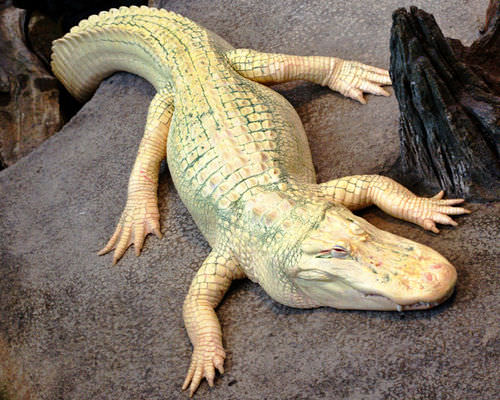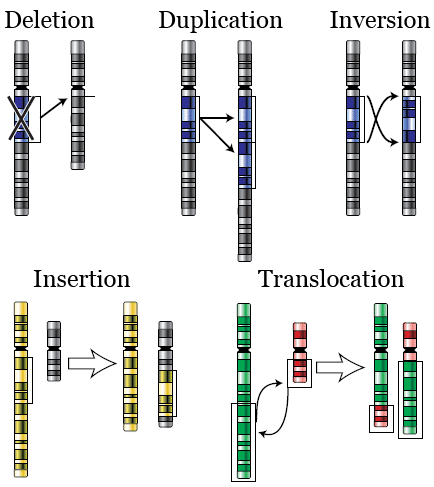4.12: Mutation
- Page ID
- 12086
\( \newcommand{\vecs}[1]{\overset { \scriptstyle \rightharpoonup} {\mathbf{#1}} } \)
\( \newcommand{\vecd}[1]{\overset{-\!-\!\rightharpoonup}{\vphantom{a}\smash {#1}}} \)
\( \newcommand{\dsum}{\displaystyle\sum\limits} \)
\( \newcommand{\dint}{\displaystyle\int\limits} \)
\( \newcommand{\dlim}{\displaystyle\lim\limits} \)
\( \newcommand{\id}{\mathrm{id}}\) \( \newcommand{\Span}{\mathrm{span}}\)
( \newcommand{\kernel}{\mathrm{null}\,}\) \( \newcommand{\range}{\mathrm{range}\,}\)
\( \newcommand{\RealPart}{\mathrm{Re}}\) \( \newcommand{\ImaginaryPart}{\mathrm{Im}}\)
\( \newcommand{\Argument}{\mathrm{Arg}}\) \( \newcommand{\norm}[1]{\| #1 \|}\)
\( \newcommand{\inner}[2]{\langle #1, #2 \rangle}\)
\( \newcommand{\Span}{\mathrm{span}}\)
\( \newcommand{\id}{\mathrm{id}}\)
\( \newcommand{\Span}{\mathrm{span}}\)
\( \newcommand{\kernel}{\mathrm{null}\,}\)
\( \newcommand{\range}{\mathrm{range}\,}\)
\( \newcommand{\RealPart}{\mathrm{Re}}\)
\( \newcommand{\ImaginaryPart}{\mathrm{Im}}\)
\( \newcommand{\Argument}{\mathrm{Arg}}\)
\( \newcommand{\norm}[1]{\| #1 \|}\)
\( \newcommand{\inner}[2]{\langle #1, #2 \rangle}\)
\( \newcommand{\Span}{\mathrm{span}}\) \( \newcommand{\AA}{\unicode[.8,0]{x212B}}\)
\( \newcommand{\vectorA}[1]{\vec{#1}} % arrow\)
\( \newcommand{\vectorAt}[1]{\vec{\text{#1}}} % arrow\)
\( \newcommand{\vectorB}[1]{\overset { \scriptstyle \rightharpoonup} {\mathbf{#1}} } \)
\( \newcommand{\vectorC}[1]{\textbf{#1}} \)
\( \newcommand{\vectorD}[1]{\overrightarrow{#1}} \)
\( \newcommand{\vectorDt}[1]{\overrightarrow{\text{#1}}} \)
\( \newcommand{\vectE}[1]{\overset{-\!-\!\rightharpoonup}{\vphantom{a}\smash{\mathbf {#1}}}} \)
\( \newcommand{\vecs}[1]{\overset { \scriptstyle \rightharpoonup} {\mathbf{#1}} } \)
\(\newcommand{\longvect}{\overrightarrow}\)
\( \newcommand{\vecd}[1]{\overset{-\!-\!\rightharpoonup}{\vphantom{a}\smash {#1}}} \)
\(\newcommand{\avec}{\mathbf a}\) \(\newcommand{\bvec}{\mathbf b}\) \(\newcommand{\cvec}{\mathbf c}\) \(\newcommand{\dvec}{\mathbf d}\) \(\newcommand{\dtil}{\widetilde{\mathbf d}}\) \(\newcommand{\evec}{\mathbf e}\) \(\newcommand{\fvec}{\mathbf f}\) \(\newcommand{\nvec}{\mathbf n}\) \(\newcommand{\pvec}{\mathbf p}\) \(\newcommand{\qvec}{\mathbf q}\) \(\newcommand{\svec}{\mathbf s}\) \(\newcommand{\tvec}{\mathbf t}\) \(\newcommand{\uvec}{\mathbf u}\) \(\newcommand{\vvec}{\mathbf v}\) \(\newcommand{\wvec}{\mathbf w}\) \(\newcommand{\xvec}{\mathbf x}\) \(\newcommand{\yvec}{\mathbf y}\) \(\newcommand{\zvec}{\mathbf z}\) \(\newcommand{\rvec}{\mathbf r}\) \(\newcommand{\mvec}{\mathbf m}\) \(\newcommand{\zerovec}{\mathbf 0}\) \(\newcommand{\onevec}{\mathbf 1}\) \(\newcommand{\real}{\mathbb R}\) \(\newcommand{\twovec}[2]{\left[\begin{array}{r}#1 \\ #2 \end{array}\right]}\) \(\newcommand{\ctwovec}[2]{\left[\begin{array}{c}#1 \\ #2 \end{array}\right]}\) \(\newcommand{\threevec}[3]{\left[\begin{array}{r}#1 \\ #2 \\ #3 \end{array}\right]}\) \(\newcommand{\cthreevec}[3]{\left[\begin{array}{c}#1 \\ #2 \\ #3 \end{array}\right]}\) \(\newcommand{\fourvec}[4]{\left[\begin{array}{r}#1 \\ #2 \\ #3 \\ #4 \end{array}\right]}\) \(\newcommand{\cfourvec}[4]{\left[\begin{array}{c}#1 \\ #2 \\ #3 \\ #4 \end{array}\right]}\) \(\newcommand{\fivevec}[5]{\left[\begin{array}{r}#1 \\ #2 \\ #3 \\ #4 \\ #5 \\ \end{array}\right]}\) \(\newcommand{\cfivevec}[5]{\left[\begin{array}{c}#1 \\ #2 \\ #3 \\ #4 \\ #5 \\ \end{array}\right]}\) \(\newcommand{\mattwo}[4]{\left[\begin{array}{rr}#1 \amp #2 \\ #3 \amp #4 \\ \end{array}\right]}\) \(\newcommand{\laspan}[1]{\text{Span}\{#1\}}\) \(\newcommand{\bcal}{\cal B}\) \(\newcommand{\ccal}{\cal C}\) \(\newcommand{\scal}{\cal S}\) \(\newcommand{\wcal}{\cal W}\) \(\newcommand{\ecal}{\cal E}\) \(\newcommand{\coords}[2]{\left\{#1\right\}_{#2}}\) \(\newcommand{\gray}[1]{\color{gray}{#1}}\) \(\newcommand{\lgray}[1]{\color{lightgray}{#1}}\) \(\newcommand{\rank}{\operatorname{rank}}\) \(\newcommand{\row}{\text{Row}}\) \(\newcommand{\col}{\text{Col}}\) \(\renewcommand{\row}{\text{Row}}\) \(\newcommand{\nul}{\text{Nul}}\) \(\newcommand{\var}{\text{Var}}\) \(\newcommand{\corr}{\text{corr}}\) \(\newcommand{\len}[1]{\left|#1\right|}\) \(\newcommand{\bbar}{\overline{\bvec}}\) \(\newcommand{\bhat}{\widehat{\bvec}}\) \(\newcommand{\bperp}{\bvec^\perp}\) \(\newcommand{\xhat}{\widehat{\xvec}}\) \(\newcommand{\vhat}{\widehat{\vvec}}\) \(\newcommand{\uhat}{\widehat{\uvec}}\) \(\newcommand{\what}{\widehat{\wvec}}\) \(\newcommand{\Sighat}{\widehat{\Sigma}}\) \(\newcommand{\lt}{<}\) \(\newcommand{\gt}{>}\) \(\newcommand{\amp}{&}\) \(\definecolor{fillinmathshade}{gray}{0.9}\)
What causes albinism?
This rare albino alligator must have the specific "instructions," or DNA, to have this quality. The cause of albinism is a mutation in a gene for melanin, a protein found in skin and eyes. Such a mutation may result in no melanin production at all or a significant decline in the amount of melanin.
Mutations
A change in the sequence of bases in DNA or RNA is called a mutation. Does the word mutation make you think of science fiction and bug-eyed monsters? Think again. Everyone has mutations. In fact, most people have dozens or even hundreds of mutations in their DNA. Mutations are essential for evolution to occur. They are the ultimate source of all new genetic material - new alleles - in a species. Although most mutations have no effect on the organisms in which they occur, some mutations are beneficial. Even harmful mutations rarely cause drastic changes in organisms.
Types of Mutations
There are a variety of types of mutations. Two major categories of mutations are germline mutations and somatic mutations.
- Germline mutations occur in gametes. These mutations are especially significant because they can be transmitted to offspring and every cell in the offspring will have the mutation.
- Somatic mutations occur in other cells of the body. These mutations may have little effect on the organism because they are confined to just one cell and its daughter cells. Somatic mutations cannot be passed on to offspring.
Mutations also differ in the way that the genetic material is changed. Mutations may change the structure of a chromosome or just change a single nucleotide.
Chromosomal Alterations
Chromosomal alterations are mutations that change chromosome structure. They occur when a section of a chromosome breaks off and rejoins incorrectly or does not rejoin at all. Possible ways these mutations can occur are illustrated in the Figure below.
 Chromosomal Alterations. Chromosomal alterations are major changes in the genetic material.
Chromosomal Alterations. Chromosomal alterations are major changes in the genetic material.Chromosomal alterations are very serious. They often result in the death of the organism in which they occur. If the organism survives, it may be affected in multiple ways.
Point Mutations
A point mutation is a change in a single nucleotide in DNA. This type of mutation is usually less serious than a chromosomal alteration. An example of a point mutation is a mutation that changes the codon UUU to the codon UCU. Point mutations can be silent, missense, or nonsense mutations, as shown in the Table below. The effects of point mutations depend on how they change the genetic code.
| Type | Description | Example | Effect |
|---|---|---|---|
| Silent | mutated codon codes for the same amino acid | CAA (glutamine) → CAG (glutamine) | none |
| Missense | mutated codon codes for a different amino acid | CAA (glutamine) → CCA (proline) | variable |
| Nonsense | mutated codon is a premature stop codon | CAA (glutamine) → UAA (stop) | usually serious |
Frameshift Mutations
A frameshift mutation is a deletion or insertion of one or more nucleotides that changes the reading frame of the base sequence. Deletions remove nucleotides, and insertions add nucleotides. Consider the following sequence of bases in RNA:
AUG-AAU-ACG-GCU = start-asparagine-threonine-alanine
Now, assume an insertion occurs in this sequence. Let’s say an A nucleotide is inserted after the start codon AUG:
AUG-AAA-UAC-GGC-U = start-lysine-tyrosine-glycine
Even though the rest of the sequence is unchanged, this insertion changes the reading frame and thus all of the codons that follow it. As this example shows, a frameshift mutation can dramatically change how the codons in mRNA are read. This can have a drastic effect on the protein product.
Summary
- Germline mutations occur in gametes. Somatic mutations occur in other body cells.
- Chromosomal alterations are mutations that change chromosome structure.
- Point mutations change a single nucleotide.
- Frameshift mutations are additions or deletions of nucleotides that cause a shift in the reading frame.
Review
- Identify three types of chromosomal alterations.
- Distinguish among silent, missense, and nonsense point mutations.
- What is a frameshift mutation? What causes this type of mutation?
- Assume that a point mutation changes the codon AUU to AUC. Why is this a silent mutation?
- Look at the following mutation: AUG-GUC-CCU-AAA → AUG-AGU-CCC-UAA-A. The base A was inserted following the start codon AUG. Describe how this mutation affects the encoded amino acid sequence.
- Compare and contrast germline mutations and somatic mutations.
| Image | Reference | Attributions |
 |
[Figure 1] | Credit: Tom Hilton Source: http://www.flickr.com/photos/tomhilton/8587793196/ License: CC BY 2.0 |
 |
[Figure 2] | Credit: Courtesy of the National Human Genome Research Institute, User:Dietzel65/De.Wikipedia Source: commons.wikimedia.org/wiki/File:Chromosomenmutationen.png License: Public Domain |

